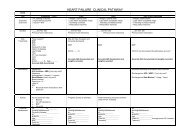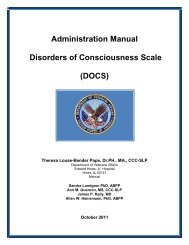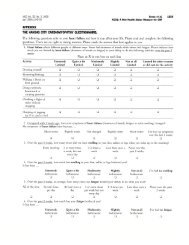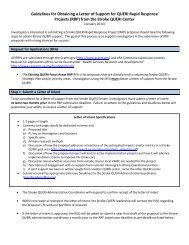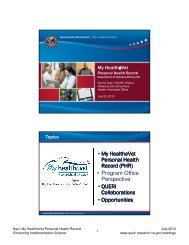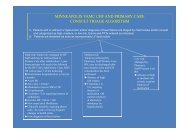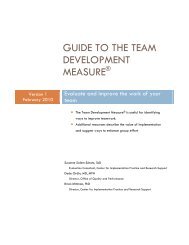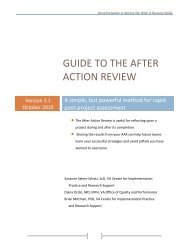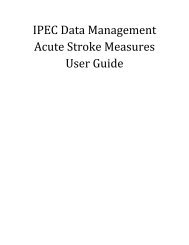The Veteran Supported Education Service Treatment Manual: VetSEd
The Veteran Supported Education Service Treatment Manual: VetSEd
The Veteran Supported Education Service Treatment Manual: VetSEd
You also want an ePaper? Increase the reach of your titles
YUMPU automatically turns print PDFs into web optimized ePapers that Google loves.
Worksheet # 9a/b: Ups and Downs for Going to School & for Going to School AND<br />
Working<br />
Adapted from Miller and Rollnick (2002), this Worksheet assists providers in structuring<br />
a costs/benefits discussion with <strong>Veteran</strong>s identified as pre-contemplating or<br />
contemplating education. Peer <strong>VetSEd</strong> providers ask what are the ups and downs to going<br />
to school, as well as what are the ups and downs of both going to school and working at<br />
the same time. <strong>The</strong>n, they list the actual responses in the proper column. If <strong>Veteran</strong>s find<br />
it hard to identify items, then providers may frame the question in terms of daily, shortterm,<br />
and long-term costs and benefits. After completing the tool, they ask <strong>Veteran</strong>s to<br />
pick which side seems to have greater significance.<br />
Worksheet # 19: Ready, Able, Willing, and Resource Ruler<br />
Adapted from Miller and Rollnick (2002), this Worksheet allows providers to ask<br />
<strong>Veteran</strong>s to pick a number between 1 and 10, with 1 being not prepared at all and 10<br />
being extremely prepared. Providers complete four ruler ratings on <strong>Veteran</strong>s‘ readiness<br />
(time), ability (skills), willingness (priority), and resources (supports) to go to school. For<br />
each area, providers ask the following questions and list responses. a) What are the<br />
reasons for picking this number? b) What can you do to move up to the next number? c)<br />
Why are you not one less than the number you picked? <strong>The</strong>se questions help ready<br />
<strong>Veteran</strong>s to make a change while supporting <strong>Veteran</strong> self-efficacy.<br />
Worksheet #20: <strong>Education</strong> Questionnaire<br />
This questionnaire provides an opportunity to explore perspectives on costs and benefits<br />
and values related to education. Providers initially ask the closed ended questions; in<br />
turn, they go back to the first question and ask the following question for each item. ―Tell<br />
me about your response to question ____.‖ This tool allows providers and <strong>Veteran</strong>s to<br />
explore education issues and values that may not have been uncovered during previous<br />
costs/benefits and ruler discussions about education. To develop a plan for education<br />
behavior adjustment, providers may utilize Worksheet #21: <strong>Education</strong> Change Plan<br />
(Miller & Rollnick, 2002). With seven items, this intervention develops a plan to adjust<br />
behaviors needed to obtain education.<br />
<strong>The</strong>se worksheets provide guidance for education providers assisting <strong>Veteran</strong>s pursuing<br />
educational goals. <strong>The</strong> following section describes a case example using the worksheets<br />
described above. This case example demonstrates a <strong>Veteran</strong> initially contemplating<br />
school and moving towards being in the action stage of going to school. We utilize the<br />
<strong>Veteran</strong> for the entire case study and for each session and we provide a <strong>Veteran</strong><br />
92 | P a g e



